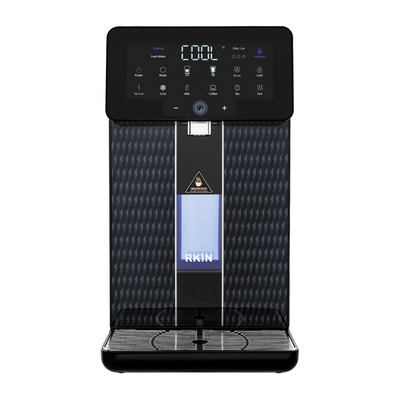
The RKIN U1 is an all-in-one water filter and hot/cold water dispenser that uses reverse osmosis to purify drinking water before dispensing it at your chosen temperature. The U1 greatly improved our water quality, reducing TDS by almost 80% and eliminating contaminants including lead, fluoride, zinc, uranium, and copper. Despite its remineralization filter, the U1 still reduced the healthy minerals in our water, and we thought that having to frequently fill and empty the water tanks was a hassle.
What We Like
What We Don’t Like
| Price | $749.95 |
| Contaminants Removed | 99% of most contaminants |
| Certifications | NSF 58 (in progress) |
| Process | Mechanical + Carbon + RO + Alkaline + Hydrogen infusion |
| Filtration Capacity | 6, 12, 24 months |
| Annual Cost | ~$180 |
| Warranty | 1-year warranty & 1 year money-back guarantee |
Table of Contents
📊 Scoring Data
We carry out our own testing to obtain our scoring data for our reviews. When relevant, we also find supplementary information from third-party lab test data, marketplaces like Amazon, and company websites. We use 6 main testing categories to rank the performance, design quality, ease of use, and overall value for money of the water filters we test. We’ve highlighted the scores we awarded the RKIN U1 for each of these categories in the table below.
| Criteria | Results |
|---|---|
| Health Related Contaminants | 9.30 |
| Aesthetic Related Contaminants | 9.90 |
| Performance Certification | Not certified for any reduction claims |
| Filtration Rate | 0.07 GPM |
| Component Quality | Outstanding |
| Component Certification | Not certified |
| Setup | Exceptional |
| Servicing Requirements | Exceptional |
| Costs | $0.08/gallon |
| Warranty Length | 1 year |
| Shipping | Free shipping on orders over $175 to lower 48 states |
| Returns | 30 days |
🎬 Video Review
🚰 Contaminant Reduction
Score: 9.00To obtain a score for contaminant reduction, we objectively tested the RKIN U1 ourselves, then compared our test results with the manufacturer’s contaminant reduction claims.
Our Performance Testing
Score: 9.00
We wanted to test the RKIN U1 in real-life conditions to see what it could remove from our drinking water supply. To do this, we used a third-party laboratory, SimpleLab’s Tap Score, which sent us a testing kit and instructions for taking samples of our unfiltered tap water and purified water from the U1.

To ensure we tested as accurately as possible, we followed Tap Score’s strict sample-taking protocol. We filled a large, clean bucket with water from our tap and swirled it around to make sure it was thoroughly mixed. We then filled the U1’s tank with the bucket water and took the pre-filtration sample directly from the bucket once it was emptier and easier to pour from. Once the water had been purified by the U1, we dispensed it from the unit into the sample vial.
We sent both samples to the lab, and our test results were delivered to us within just under a week.
Health-Related Contaminants
Score: 9.30
Our unfiltered water contained 11 contaminants with potential health effects, and three of these – fluoride, lead, and uranium – were detected in concentrations higher than the HGL. Copper, zinc, nitrate, molybdenum, sulfate, barium, strontium, and sodium were also detected in trace amounts. All these contaminants have a number of possible health risks, including:
- Blood system issues
- Kidney and liver problems
- Developmental and skeletal issues
- Immune effects
- Nervous system problems
- Cardiovascular effects
- Impacts on the reproductive organs
- Carcinogenic (cancer-causing) effects
- Gastrointestinal outcomes
In our post-filtration test results, we could see that the RKIN U1 had done exactly what we’d expected from a reverse osmosis system: most of these contaminants had been eliminated.
| Contaminant | Measurement | Pre-Filtration | Post-Filtration | % Change |
|---|---|---|---|---|
| Barium | PPM | 0.014 | 0.0087 | -37.86% |
| Calcium | PPM | 23.9 | 3.6 | -84.94% |
| Chloride | PPM | 9.2 | 0 | -100.00% |
| Copper | PPM | 0.0525 | 0 | -100.00% |
| Fluoride | PPM | 1.5 | 0 | -100.00% |
| Lead | PPM | 0.0009 | 0 | -100.00% |
| Magnesium | PPM | 6.08 | 0.39 | -93.59% |
| Molybdenum | PPM | 0.0047 | 0 | -100.00% |
| Nitrate (as N) | PPM | 2.1 | 0.2 | -90.48% |
| Phosphorus | PPM | 1.1 | 0 | -100.00% |
| Sodium | PPM | 9.91 | 1.2 | -87.89% |
| Strontium | PPM | 0.108 | 2.42 | 2140.74% |
| Sulfate | PPM | 7.6 | 1.6 | -78.95% |
| Total Dissolved Solids | PPM | 112 | 23 | -79.46% |
| Uranium | PPM | 0.0182 | 0 | -100.00% |
| Zinc | PPM | 0.559 | 0 | -100.00% |
Barium, nitrate, and sulfate remained in much lower concentrations (0.0087 PPM, 0.2 PPM, and 1.6 PPM compared to our unfiltered water’s 0.14 PPM, 2.1 PPM, and 7.6 PPM, respectively).
Strontium actually increased by 2,140% from just 0.1 to 2.42 PPM, which leads us to believe that there are traces of strontium in the remineralization filter media. We see it is still below the Health Guideline Level of 3 PPM, so we’re not too concerned about this.
Minerals & Salts
The reverse osmosis filtration process eliminates pretty much everything from a water supply, including the good stuff. The RKIN U1 is no different in its performance, but it features an alkaline post-filter that’s designed to add healthy minerals back into the purified water.
We could see from the results that the filter had added some minerals – 3.6 PPM of calcium and 0.39 PPM of magnesium were detected – but we still lost most of the minerals from our water. Originally, the calcium reading had been 23.9 PPM, and the magnesium concentration was 6.08 PPM. We wish our post-filtered water was a little more mineral-rich.
Aesthetic Contaminants
Score: 9.90
The second-stage filter in the RKIN U1 is a carbon block filter. Activated carbon is favored for its ability to remove chlorine, tastes, and odors – a 2013 research-backed NebGuide report comments that carbon filters can “effectively reduce certain organic compounds and chlorine in drinking water”.
We used a test strip sent by Tap Score to determine how much chlorine our unfiltered and filtered water supplies contained. Chlorine is volatile and dissipates quickly, which is why we did this test ourselves rather than getting our water tested for chlorine at the lab.
Around 0.5 PPM of chlorine was detected in our unfiltered tap water, and the RKIN U1 eliminated 100% of this chemical. We noticed that our purified water tasted cleaner and didn’t have the recognizable “swimming pool” chlorine odor.
Performance Certifications
Score: 6.00
RKIN has applied for an NSF certification to Standard 58, for reverse osmosis performance, for the U1 system. From what we can gather, this certification was applied for back in August 2022, but we can’t currently find the product listed in the NSF’s catalog of certified water filters, or the IAPMO or WQA databases (the NSF certification process can take quite a while).
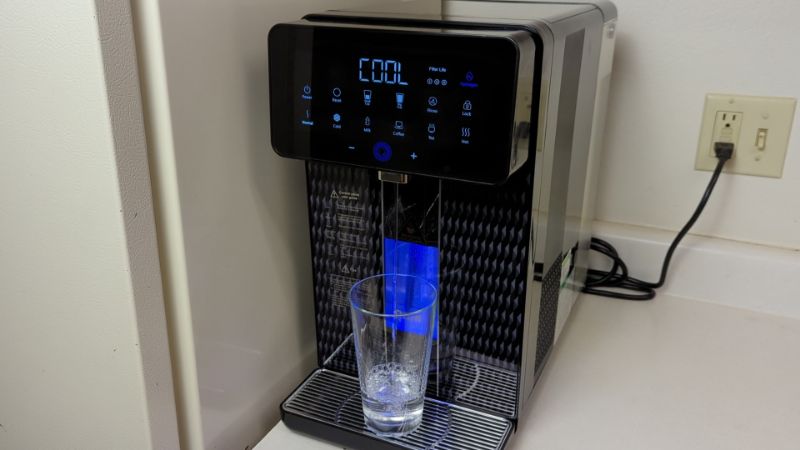
The manufacturer did give us access to the unit’s IAPMO testing results for its ability to reduce or remove contaminants including TDS, fluoride, lead, chromium III, chromium VI, and PFOA/PFOS – they’re just not available on the RKIN website at the time of our review. IAMPO testing is a promising reassurance of performance, especially considering the cost of the unit. When you’re spending $700+ upfront, you especially want to know that the system you’re buying has been third-party tested and has proven to perform as advertised by the manufacturer.
Below, we’ve compared the RKIN U1’s ability to remove select contaminants from our water with testing claims for these contaminants by the manufacturer.
According to the U1’s lab results, it can remove up to 99.99% chromium III, 99.97% chromium VI, 98.29% fluoride, 99.94% lead, 98.08% PFOA, 99.14% PFOS, and 94.00% TDS.
The RKIN U1 removed 100% of lead and fluoride from our water, so it exceeded the reduction percentages in the third-party testing data.
None of the other contaminants were present in our water, so we couldn’t validate the additional third-party test results.
As for TDS reduction, the U1 only reduced around 79% TDS in our own testing. Why didn’t we see a greater TDS removal closer to 100%? Because the U1 adds minerals back into the water with a remineralization filter, and minerals contribute to TDS.
The table below compares our own testing data with third-party testing data for the RKIN U1.
| Contaminant | RKIN U1 Removal Claims (%) | WaterFilterGuru Testing Data |
|---|---|---|
| Chromium III | 99.99% | Not Detected |
| Chromium VI | 99.97% | Not Detected |
| Fluoride | 98.29% | 100% |
| Lead | 99.94% | 100% |
| PFOA | 98.08% | Not Detected |
| PFOS | 99.14% | Not Detected |
| TDS | 94.% | 79% |
🚦 Filtration Rate
Score: 7.50We timed how long it took the RKIN U1 to purify our water and found that it purified 1 gallon of water in 14 minutes, giving it an average filtration rate of 0.07 GPM (gallons per minute). That’s not the fastest we’ve seen – some of the best pressurized systems have a flow rate of 2 GPM or more – but it wasn’t excruciatingly slow either.
Boiling water was delivered almost instantly too thanks to the system’s instant-hot technology. This was a major perk for us, meaning we could enjoy hot water for drinking and cooking without having to dispense the water and then boil it separately.
If you’ve never used a countertop RO system before, it’s worth managing your expectations. Your water won’t be dispensed as fast as it is from your faucet, but you should still expect a steady flow.
Efficiency Ratio
All reverse osmosis systems waste water during the RO process. This is due to the design of the membrane – it rejects contaminants, causing them to rebound back into the RO chamber, rather than trapping them in its pores, which means the contaminants must be flushed away with a small amount of wastewater.
The RKIN U1 has a 1:1 wastewater to pure water ratio, meaning that 1 gallon of water is wasted for every 1 gallon of pure water produced. This is very efficient compared to the average pure-water-to-wastewater ratio of 1:4 for conventional reverse osmosis systems. So, while we were still having to dump half the water produced by the RKIN U1 (it’s dispensed into a separate compartment), we could enjoy a decent amount of purified water, too.

Is the U1’s 1:1 ratio the best we’ve ever seen for a countertop unit? No. The AquaTru, another countertop RO system we’ve tested, has an unbeatable 4:1 efficiency ratio, meaning it only wastes 1 gallon of water for every 4 gallons of filtered water produced. But then the AquaTru unit doesn’t offer many of the U1’s benefits, like hot water dispensing and hydrogen infusion.
📐 Design
Score: 7.50We used two key factors to test the RKIN U1 in the design category: its component quality and whether or not it was certified for materials safety.
Out of the box, the RKIN U1 is a mid-sized system with a sleek black design and a touch control panel. It measures 17 inches tall – about the same height as a countertop minifridge. We could buy the system with a turntable, at an extra cost of $60. It’s not essential, but means you have easier access to the back of the unit, which is where the filters and water tank are.
Speaking of filters, our unit came with all three initial filter cartridges: the CF filter, the RO filter, and the PAC filter (more on these later). The unit houses all the filters and water tanks neatly inside.
Design-wise, the U1 is one of the most complex and impressive we’ve seen. It’s pretty technical and advanced, but all the hard work takes place in the machine itself. Something we will say is that the touch-screen control panel takes a bit of getting used to – there’s a whole double-page spread in the user manual that goes through what all the different icons and buttons mean – but now that we’ve used the system for a while, we regularly use or get value from every single preset and status indicator, so we personally wouldn’t want the interface to be simplified.

Design Setbacks
There’s just a couple setbacks that we want to highlight for the RKIN U1’s design.
The U1 is a standalone unit that isn’t plumbed into a water line, so it was our job to keep the tank topped up. This meant detaching the water tank from the back of the unit. We also had to periodically empty the wastewater tank, which filled quite quickly due to the system’s 1:1 efficiency ratio.
The filtered water holding capacity is half a gallon, so big families will need to top up the water and empty the wastewater tank often.
The unfiltered water holding tank is tall, so it might not fit under some faucets. As in our case, we needed to use the pullout sprayer handle to fill it.
Component Quality
Score: 9.50
We were generally pleased with the quality of the components in the U1.
The unit is made from polypropylene, a BPA-free plastic that RKIN says is “the safest kind of plastic” to use in products that are designed to store food and beverages. It’s heat-resistant – an essential feature in the U1, which heats water to 112°F.
A Healthline article on polypropylene noted that the EPA considers polypropylene to be safer than some other types of plastics, but we were unable to find evidence of this in our research, and there was a study conducted in 2019 that found that some polypropylene products caused a toxic or stress response in cells and affected hormones.
We know that most folks want to avoid plastic as much as possible, but unfortunately, plastic is used in most water filters because it has the advantage of being cheap, sturdy, lightweight, and pretty durable. But at least RKIN has tried to limit contact with plastic as much as possible.
For instance, the nozzle is made of polypropylene plastic, but it has an inner silicone tube, meaning that water won’t touch the nozzle that you can see from the outside.
The material tank is made of ABS (acrylonitrile butadiene styrene), which is considered a safe and BPA-free plastic.
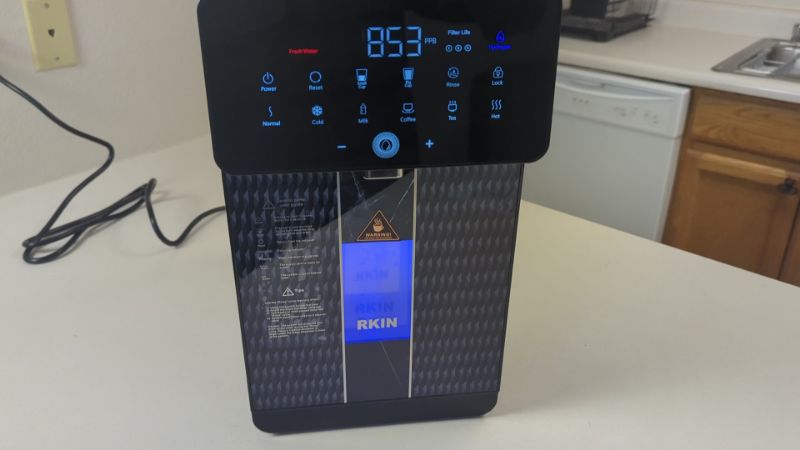
Design Longevity
We couldn’t find any conclusive evidence for the lifespan of polypropylene, but sources on the internet say that most polypropylene products last around 20 years.
Because polypropylene is less prone to shattering like glass, and won’t rust like metal, we think the materials used in the U1 should last decades.
However, the U1 uses electronics, which are less reliable. You’ll probably have to replace the entire system if it malfunctions or stops working.
Certification
Score: 6.00
Water filters can obtain specific certifications for design safety, such as NSF 372, for lead-free design. They can also be certified for materials safety and structural integrity as part of their performance certifications.
We couldn’t find any evidence of certifications for materials safety for the RKIN U1 in our research.
Filter Materials
There are five water treatment stages in the RKIN U1. The first and second stages are sediment and carbon filters, followed by an encapsulated reverse osmosis membrane (RO membranes are typically made from cellulose acetate blends or polyamide composites). There’s also an alkaline post-filter and a hydrogen module, but we couldn’t find any information on their design materials.
In this 2017 evaluation of the effectiveness of POU filtration in addressing US drinking water risks, activated carbon was cited as an effective solution for removing “multiple categories of pollutants” including VOCs, metals, and particles. RO systems are recommended by the CDC for removing chemicals, metals, and microorganisms from water.
The filter houses contain plastic, as is usual for most water filtration systems.
⚙️ Setup
Score: 10.00We timed how long it took us to set up the RKIN U1, and made a note of how challenging we found the process.
Like all countertop RO systems, the RKIN U1 is a plug-and-play type of machine. That meant we didn’t have to commit to a DIY installation: we simply assembled it, plugged it in, filled the half-gallon water tank, and placed it in the system.
There are only 6 setup steps in the U1’s user manual, which we found easy to follow.
It’s standard practice to have to prime your water filters before using them for the first time, but the U1 has a dedicated “flush” feature, so all we had to do was press the button sequence to send water through the filters for three separate rinse cycles.
We think the U1’s zero-installation design makes it a good choice for folks who live in apartments or anyone who doesn’t want the hassle of plumbing a filtration system into their water line.
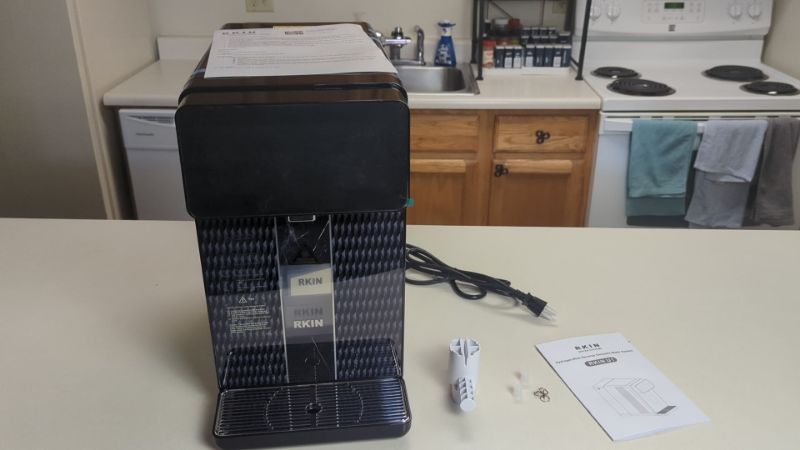
🔧 Maintenance
Score: 9.75In the Maintenance category, we evaluated the RKIN U1’s servicing requirements and the cost of replacing the filters.
Servicing Requirements
Score: 9.50
We found the RKIN U1 easy to maintain, again because of its high-tech design. The system has a few self-cleaning features, including a UV light that zaps the stored water to prevent microbial formation when it’s not in use, and the “rinse” setting, which drains the system and flushes the filters. We didn’t have to take apart the entire system to get it clean.
However, we still did need to wipe down the outside of the machine occasionally and replace the filters every 1-4 years on average. There’s a filter life notification for each of the three filters, which turns yellow once filter life reaches 80%, and red when the filter needs to be replaced, so no need to guess when new filters are needed.
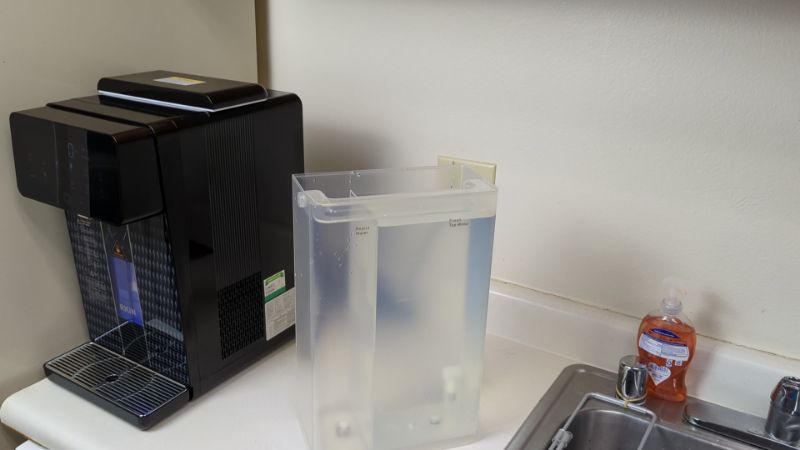
We also had to regularly dump the wastewater from the tank once it got full. This reject water contains contaminants and isn’t recommended for drinking, but we tried to make use of it for cleaning and watering our plants rather than just pouring it down the drain.
The only slightly time consuming task is replacing the hydrogen module, which requires the unit to be emptied, turned on it’s side, and opened using both a screwdriver and special key for this purpose.
Costs
Score: 10.00
We calculated the cost per gallon of the RKIN U1 filters to determine its value for money in the long term.
The overall cost per gallon for the filters is $0.0809/gallon. Here’s a breakdown of the different costs per gallon for each of the filter stages in the system:
- 2-in-1 Sediment and Carbon Pre-Filter: $0.04 per gallon
- U1 RKIN AlcaPure Alkaline Post Filter: $0.04 per gallon
- RO Membrane: $0.0009 per gallon
That means the U1 is pretty cheap to maintain compared to other filters we’ve tested, even though it uses three different filter cartridges. We found that the middle-ground average cost per gallon for water filters is $0.54-0.61/gallon.
🏢 Company
Score: 8.20In the final category, we graded the RKIN U1 based on its warranty, shipping, and returns.
Warranty
Score: 8.50
The U1 is backed by a 1-year warranty, and there’s the option to buy the 1-year extended warranty for an extra $60. You’ll need to have a purchase receipt to be eligible for the warranty. There’s no restocking fee unless you return the U1 after the 30-day return window.
Honestly, we don’t like it when manufacturers offer additional warranties at an extra cost, especially when we’re already splashing out on an expensive unit like the U1. We think the included warranty could be longer.
View the U1’s warranty terms here.
Shipping
Score: 8.00
RKIN offers free shipping on orders over $175 to the lower 48 states. Otherwise, the shipping cost is calculated during checkout, and there may be import taxes or other fees that are the buyer’s responsibility.
Returns
Score: 8.00
The RKIN U1 can be returned within 30 days of the purchase. You don’t have to pay a restocking fee within this period. However, from what we can tell, RKIN only offers store credit in exchange for returns. Here’s the refund policy for more information.
We’ve seen returns periods as long as 90 days – but we’re still pretty happy with RKIN’s offering, and it’s good to see that you can still return the U1 even if it has been used.
Found this review helpful?
Comment below or share this article!

